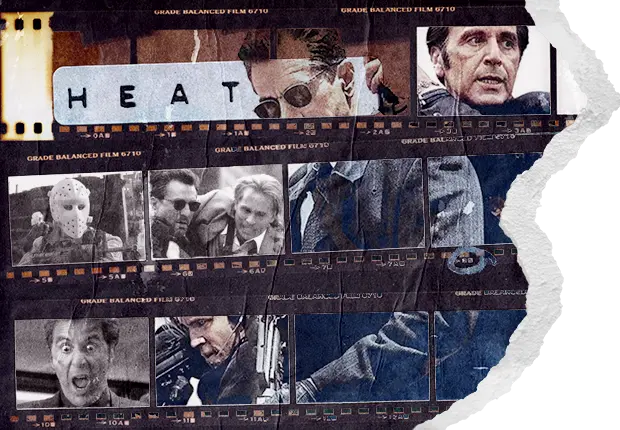Heat
Heat (1995) begins with a question. It opens with a long shot of a train yard, the many lights of Los Angeles reduced to smears by the depth of field, long rails running off into the early morning dark. A train pulls up—a commuter train. There’s a wonderful little wink that accompanies the question mark of this opening shot: In a city renowned for cars and smog, why open with a train?
Why indeed. Because it’s filled with commuters, commuters who rose well before the sun and are already on their way into the city. Cars can presumably take people to any destination, but riding a train is more planned, more of a routine, especially in the early morning hours. And De Niro is among the commuters, the people who have been planning. And the planning pays off as he and his team knock over—literally—an armored car.
By the time we see Pacino, he is making love to his wife in the morning sunlight. “Wasting” his time on things like “love” and “family.” By the time he gets to the crime scene it’s night—at least 12 hours after it all went down. He’s gonna have to get up a lot earlier than that if he wants to compete.
At the end of the day, Heat is about the non-stop pressure on working professionals. The idea that you have to be “on” all the time. #sigmagrindset. De Niro lives that way: barely ever sleeping, no furniture in his empty house. When he finally meets a woman, she asks what book he’s reading. “Stress Fractures in Titanium,” he mumbles back before deciding to break his own rule and talk to her. He is titanium, as tough as they come, and even for him the cracks are starting to show.
Pacino, of course, is at odds with his family life from the beginning. It’s a cycle he’s used to (“I’m on the downslope of a marriage, my third,” he tells De Niro in the diner), but he is still oblivious to his own personal failings that are the real cause. When his step daughter (Natalie Portman) is excited about her biological father taking her out for a day, he offhandedly comments, “Is he going to show, or is that son of a bitch gonna stand her up like last time?” before spending the rest of the movie standing up his own wife. Maybe Natalie’s father is a professional too.
The city of LA is similarly stripped of anything warm. The houses they reside in are cold, with sharp corners and white walls. The police headquarters is all concrete, a brutalist bunker. The policemen themselves are practically wall street brokers: they wear white shirts with the sleeves rolled up, and are always making urgent phone calls at Pacino’s behest. Money never sleeps.
The two scenes that everyone remembers are the extremes in the film, and what make it truly special. The diner scene, where De Niro and Pacino get to lament their similar situations to each other, and come away resolved to collide. A promise made good on in the climactic shootout as the bank heist explodes into a rolling gunfight through downtown LA.
The gunfight has a cherished place in film history, and it deserves one, the fodder for a thousand youtube tributes. The sound design emphasizes the buildings around them, the percussive booms of their automatic rifles making the avenues into canyons. It’s no coincidence it takes place where professionals work. Even in this it is perfectly balanced. De Niro’s crew is hopelessly outnumbered, but the cops are, somehow, terribly outgunned.
What always surprises me is that there’s still forty minutes to go in the film after the downtown shootout. The end of the movie starts to drag, with De Niro infiltrating a hotel the same way he stole an ambulance at the beginning of the film.
The true ending though, as De Niro flees on foot to the airport and Pacino follows him in the dark, has grown on me. They hunt each other through a dark field with square containers spaced in long rows. Occasionally a plane takes off or lands, massive strings of lights, illumination turned to smears by the depth of field. De Niro has fled to the ends of the earth, with the city reduced to mere cubes, its simplest forms, the lights of the city now the floating lights of the runways. Pacino gets his man, and holds his hand as he dies. Two men forced, essentially, to destroy each other, against their natures but in line with their professions.
Mann has never directed another film that looks this good. It seems like a perfect blend of available technology and aesthetic. There are a few POV shots that he sneaks in there, of a kind that would become outrageous by the time Miami Vice arrived, a decade later. Mann would also revisit the same general character pattern again and again: an out-of-control cop, and a cool-as-ice professional criminal.
Heat remains totally relevant. Our culture fetishizes professionalism more than ever. Now, thanks to our smartphones, even our private lives are professionalized. The idea of individual qualities deciding our fates—personal courage, temperance, or cleverness has been discarded in favor of min-maxing every aspect of your life for an abstract goal. An arms race of self-dehumanization. One that ends in the desert, clutching the hand of a fellow traveler, feeling his life draining away. His heat.
































